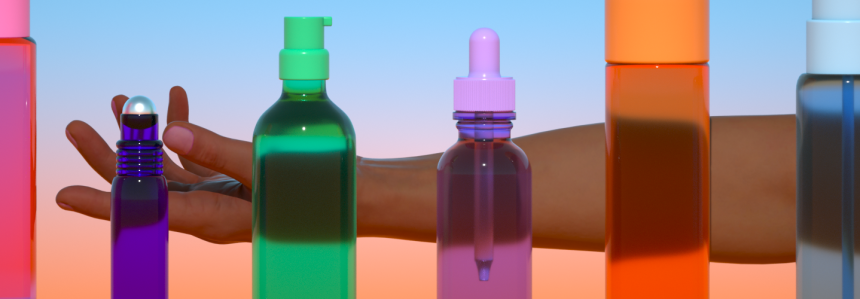My magnificence editor buddies are trustworthy. Need to know if the viral Rose Pores and skin Co. laser-hair remover actually works, or if that trending ice-water facial is B.S.? They will give it to you straight. Must know in case your current curtain bangs had been a good suggestion? Prepare for some probably painful texts. So I anticipated nothing lower than the entire fact after I not too long ago polled my editor buddies to seek out out if anybody is really patch-testing their new merchandise earlier than slathering them on. And to my shock, I used to be met with crickets.
When you’re unfamiliar, at-home patch testing includes dabbing a teeny quantity of product to an not easily seen space (usually behind the ear) to rule out contact dermatitis and allergic reactions. However regardless of being loudly preached by specialists—particularly by magnificence editors—most of my buddies admitted to by no means patch-testing their merchandise. And truthfully, I get it: Patch testing would possibly really feel like an annoying science experiment you’d somewhat keep away from, but it surely’s really invaluable for offering a selected reply to which components are irritating your pores and skin.
So forward, I’ve compiled a complete information to demystify the patch-testing course of so you may have all the data you should unravel your pores and skin allergic reactions and sensitivities. To assist, I chatted with two board-certified dermatologists (Kristina Collins, MD, and Karan Lal, DO); a board-certified allergist, Martin Smith, MD; and a beauty chemist, Ginger King, about what a patch check is, why you need to patch-test your skin-care merchandise at residence, and what occurs throughout an expert patch check. Let’s dive in.
Consultants on this article
- Martin Smith, MD, a double board-certified allergist and immunologist in Cleveland, OH
- Kristina Collins, MD, a double board-certified dermatologist based mostly in Georgetown, TX
- Karan Lal, DO, a double-board-certified dermatologist in Scottsdale, AZ
- Ginger King, a beauty chemist and product developer in New Jersey
What’s a patch check?
A patch check is a non-invasive pores and skin check to determine components you are allergic or delicate to. There are two variations: the DIY model and the skilled model. Usually seen on the again of a brand new hair dye, a DIY patch check merely refers to dabbing a little bit of product on a small space (usually behind your ear or inside your forearm) to see how your pores and skin reacts after 24 or extra hours.
An expert patch check, nonetheless, will be finished with a board-certified dermatologist or allergist, and the method begins within the workplace however extends past. “You retain the allergen patches they apply on, however you come back to the workplace at 48 hours, 72 hours, and 96 hours,” Dr. Lal says. “The patches come off at these visits, and we take footage and assess the response to the allergens.” In keeping with Dr. Lal, early reactions are normally indicative of irritant reactions, whereas allergens that seem at 72 hours and 96 hours are as a result of pores and skin allergens.
Whereas the simplified at-home model saves money and time, it is thought-about “much less scientific,” in response to Dr. Lal. Nonetheless, dermatologists, specialists, and wonder editors typically advocate this technique, particularly when introducing new skin-care merchandise. Nevertheless, the jury’s nonetheless out on how many individuals really observe by. For instance this, I additionally contacted my good friend with delicate pores and skin, who confessed to by no means having patch-tested her merchandise. (Even Dr. Lal admitted that he would not assume everybody’s doing it: “I can not think about attempting to check the whole lot you ever use,” he says. “It might get overwhelming.”)
Why you need to patch-test your skincare
Patch-testing your skin-care merchandise at residence will help you catch reactions early, saving time, stress, and complications in the long term. Whereas skilled patch testing is the best way to go for complete outcomes, Dr. Collins explains that there are conditions the place conducting patch assessments for skin-care merchandise at residence might suffice, particularly when a pores and skin response hasn’t been a recurring problem.
“Say you simply tried two new merchandise, your pores and skin acquired actually itchy, and also you’re attempting to determine which one of many two issues did it,” says Dr. Collins. “That could possibly be a very good time to do a patch check at residence.” On this case, you’d be capable to patch-test each merchandise, wait 24 hours, and cease utilizing the components that causes a response.
You also needs to, technically, patch check new merchandise earlier than incorporating them into your skin-care routine, particularly in the event that they comprise energetic components you are not already utilizing. This step is crucial to rule out any potential points and stop them from occurring. As a substitute of instantly slathering your face in that new moisturizer full of acid and perfume, take into account taking a day to check it behind your ear. This straightforward precaution will help you’re feeling extra assured about your merchandise and their results in your face.
What’s contact dermatitis?
“Contact dermatitis is a delayed-type allergic pores and skin response that occurs from making use of merchandise on to your pores and skin,” Dr. Martin says. It differs from a direct allergy you possibly can expertise from meals, seasonal pollen, or insect stings. Normally, a response occurs three to 5 days after you utilize an offending product, and you’ll have a relentless rash even for those who use that product as soon as in three weeks.
“The 2 foremost sorts of contact dermatitis are irritant and allergic,” says Dr. Martin. Though each irritant and allergic dermatitis are labeled as contact dermatitis, they’re completely different. Dr. Lal says allergic dermatitis kicks your immune system into gear at a molecular degree. However, Dr. Collins explains that sensitivity could make your pores and skin burn or sting instantly: “Identical to some individuals get actually irritated and their eyes tear up when peeling onions, some individuals are bothered equally with components.”
Contact dermatitis has the potential to happen anyplace on the physique. Dr. Collins notes that a number of the most typical areas the place sufferers expertise it embrace their eyelids, lips, face, and arms. She explains that whilst you might affiliate the placement of your dermatitis with a product you utilize in that space, similar to an eye fixed cream in your eyelids, this will not all the time be the case.
“Generally, reactions generally is a little deceiving,” says Dr. Collins. “One of the crucial widespread causes individuals bear patch testing is due to eyelid dermatitis, which is a frequent manifestation of contact dermatitis because of the thinness of the eyelid pores and skin.” Mainly, due to its thinness, your eyelids are extra reactive than different elements of your physique. So it’s possible you’ll assume the offender is a brand new eye cream, but it surely is also one thing like your nail polish. “Whenever you scratch your face, the fragile eyelid pores and skin turns into inclined to creating an allergic response,” Dr. Collins says.
Her suggestion? When you’re making an attempt to determine the reason for a response, “begin by conserving a diary and logging the whole lot that comes into contact along with your pores and skin,” says Dr. Collins, “whether or not it is shampoo, conditioner, moisturizer, cosmetics, or anything.” This may be useful in figuring out which merchandise to patch-test at residence—or, consequently, useful in stressing you out sufficient that you just go for an expert check along with your dermatologist.
Widespread allergens in skincare and beauty merchandise
Whether or not you have got a response to a product at residence or to the allergen stickers in a physician’s workplace, the underlying irritant could possibly be the identical allergen. When you’re undecided the place to start out and also you don’t have entry to a dermatologist for skilled patch testing (it may be costly with out insurance coverage), it’s possible you’ll need to keep away from the next widespread allergens:
Perfume
“The commonest allergens are fragrances, together with botanical compounds similar to important oils,” Dr. Smith says. Perfume allergic reactions are so widespread amongst Dr. Collins’ sufferers that she encourages individuals to keep away from them fully.
Lanolin
Lanolin is an ingredient from sheep’s wool. It is typically utilized in skin-care merchandise for its moisturizing advantages, although our specialists level out that it is also a typical allergen. “The scary factor is that many manufacturers marketed to infants and other people with eczema or delicate pores and skin comprise allergens similar to lanolin,” says Dr. Smith.
Formaldehyde-releasing preservatives
Quaternium-15 is a super-common formaldehyde-releasing preservative used to lengthen the shelf-life of merchandise. It’s additionally strongly disliked by all of our interviewed specialists as a result of its excessive danger of irritation. In keeping with a 2022 Pubmed scientific evaluate, it’s a recognized allergen, which is able to usually be listed as one of many ultimate components on a product’s components checklist.
Nickel
Nickel is not simply restricted to the buttons of your denims or zippers—it’s additionally present in sure cosmetics, like mascara. In keeping with Dr. Smith nickel will be present in hint quantities in colorants, notably in blue and inexperienced pigments, but it surely’s normally solely trigger for concern if there’s a response. Reactions to most of those allergens might seem as contact dermatitis.
Tips on how to patch-test skin-care merchandise at residence
When you’re going with the at-home technique, Dr. Smith recommends making use of a quarter-size quantity of the product you need to check to the within of your forearm or elsewhere you will not by accident rub the product off. For facial merchandise, he says you may as well take into account testing behind your ear.
Dr. Smith says you may need to apply the product twice each day for a minimum of a couple of hours. However for those who do not need to reapply twice each day, he suggests a unique possibility: You may apply it simply as soon as after which “cowl the spot with a bandage and peel it off in 4 days” (or sooner, for those who really feel irritation). This time is important as a result of, as we have mentioned, contact dermatitis is a delayed-type allergic response that would take days to develop right into a rash.
Nevertheless, Dr. Smith says you need to react shortly for those who see or really feel a response. “Instantly wash the world with a mild fragrance-free cleaning soap,” he says. “If the rash worsens, which regularly occurs, you possibly can strive an OTC cortisone cream, or higher but, go in and see your physician, allergist, or dermatologist.”
Signs to look out for throughout an at-home patch check
In keeping with Dr. Smith, signs to look out for throughout an at-home patch check embrace indicators of pores and skin irritation the place you apply the product, similar to redness, swelling, raised bumps, blisters, or peeling. However, chances are high, you would possibly really feel a response like intense itching, which he additionally says is a fairly widespread symptom.
In case your signs do not enhance inside a couple of minutes or hours (or in the event that they worsen, regardless of rinsing and making use of cortisone cream), you need to see a dermatologist or physician who can probably present stronger topical or oral meds to ease your signs.
What occurs throughout an expert patch check?
Throughout an expert patch check, your supplier will check your pores and skin for widespread allergic reactions, however let’s dive deeper. For starters, Dr. Collins explains two sorts of patch assessments: the True Check and the North American 80 Complete Sequence check. The previous is “fairly restricted” (she calls it a “child check”), but it surely’s the one most frequently utilized in dermatology and allergy workplaces. The latter is a extra complete possibility that assessments for 80 allergens in comparison with the True Check’s 35.
When you and your healthcare supplier have chosen the suitable check, the procedural steps observe. Your supplier will put together and cleanse your again, after which the principle section begins: making a grid-like sample in your again and sticking particular person patches (every containing a unique allergen) onto your pores and skin. There’s the “uncommon probability” your pores and skin reacts instantly. In that case, Dr. Lal tells us your supplier will take away the patches, cease remedy, and develop a brand new recreation plan. In any other case, your supplier will ship you in your manner, and the ready recreation will start.
Sometimes, you may be requested to return for a number of follow-ups that week. Dr. Collins explains that for those who go to on a Monday, your supplier will doubtless schedule your return for Wednesday to take away the patches after which on Friday for a “ultimate look.” Throughout this ultimate examination, they’ll observe any reactions that occurred on Wednesday, in addition to those who developed by Friday, grading every allergen accordingly earlier than providing you with an inventory of your ultimate allergens (if any).
So as to add one other layer of complexity, in uncommon instances, “there could possibly be an ingredient that is simply actually particular to a person that is not on both of the patch testing collection and in that case, your supplier can design a selected check for that particular person,” Dr. Collins says. She explains that some components are occupation-specific, similar to these encountered by nail artists and hairstylists, which most people might work together with much less often. Consequently, these components will not be usually included in customary patch assessments.
Last takeaway
If you wish to keep away from a visit to the derm, patch-testing your skincare at residence is an effective first step to ruling out reactions or (some) allergens. Nevertheless, in case your pores and skin is irritated, reactive, and would not appear to be bettering—otherwise you need to go away the rash-sleuthing to the professionals—skilled allergen testing is a surefire solution to pinpoint whether or not you are coping with an irritant or allergic contact dermatitis. In any case, dermatologists and allergists spend a very good chunk of their lives learning that will help you, so do not be afraid to make the most of their very good brains for assist.
Hero Illustration by Janet Mac






